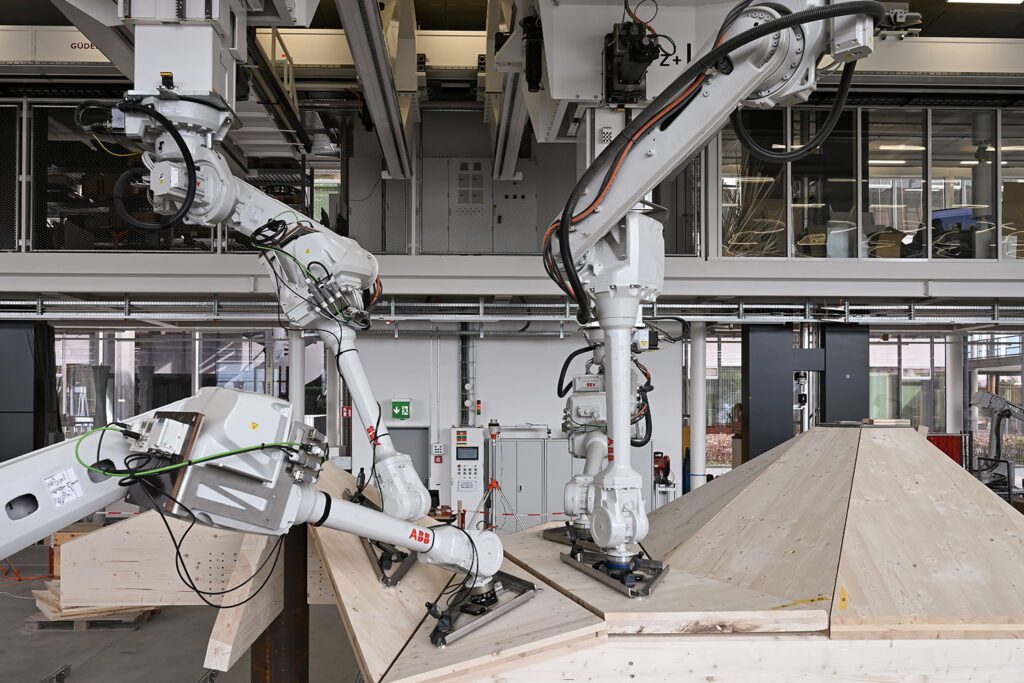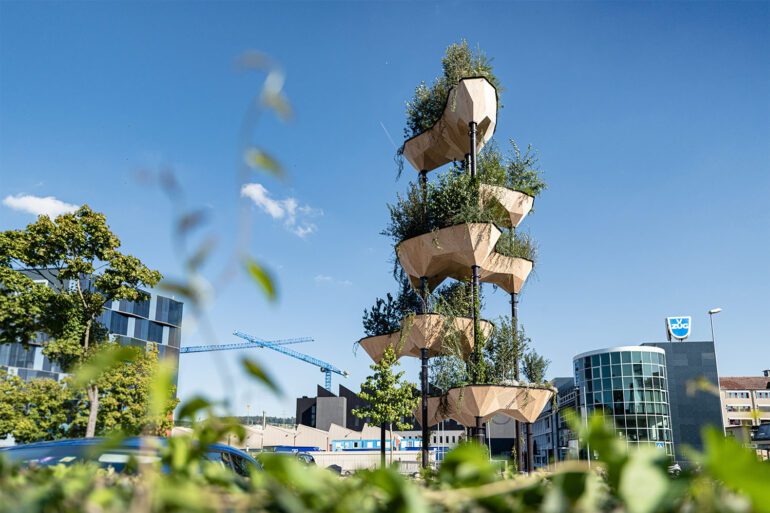TL;DR:
- Semiramis is an AI-designed architectural installation located at Zug’s Tech Cluster entrance.
- It symbolizes the collaboration between AI and humans, transcending conventional urban concepts.
- Standing at 22.5 meters, it consists of five wooden pods supported by eight steel pillars.
- AI-driven design criteria include sunshade, rain protection, and plantable surfaces.
- Computational Robotics Laboratory fine-tuned pod shapes and structural parameters.
- Cross-laminated timber plates are assembled using a novel wood bonding technique.
- Four robots work in tandem for additive manufacturing at ETH Zurich’s Robotic Fabrication Lab.
Main AI News:
In a groundbreaking fusion of cutting-edge technology and architectural innovation, Semiramis, an awe-inspiring installation, graces the entrance to Zug, Switzerland’s burgeoning Tech Cluster. Developed in 2022, this visionary project heralds the seamless collaboration between artificial intelligence and human creativity, transcending conventional urban endeavors. It stands tall as a vertical urban oasis, meticulously crafted to cater to the needs of local flora and fauna.
Semiramis owes its existence to a confluence of synergies and relentless research initiatives in the domains of interactive computational design, machine learning, and digital fabrication. Straddling the boundary between the artificial and the natural, this architectural marvel soars to a majestic height of 22.5 meters, comprising five organic, amorphous wooden pods elegantly supported by eight slender steel pillars.
The driving force behind this remarkable endeavor is a bespoke machine learning design method, ingeniously crafted by our distinguished chair in collaboration with the Swiss Data Science Center. This method empowered our team to dynamically extrapolate optimal design variations, laying the foundation for Semiramis’ compelling spatial composition. Key performance criteria, including sunshade provision, rain protection, and plantable surface area, were meticulously considered during this transformative process, as explained by the research team.

Semiramis, Tech Cluster Zug, Switzerland, 2022 © Gramazio Kohler Research, ETH Zurich. Photo: Michael Lyrenmann
Concurrently, our visionary designers joined forces with the Computational Robotics Laboratory to fashion a specialized tool. This groundbreaking innovation facilitated the fine-tuning of the complex geometry of each individual pod, all while conscientiously incorporating relevant material and fabrication parameters. This intricate balancing act preserved the flatness of the individual panels and respected their inherent size constraints, all the while bolstering structural integrity.
At the heart of Semiramis lies the ingenious assembly of cross-laminated timber plates. This process, developed through a fruitful collaboration between Gramazio Kohler Research, ETH Zurich, TS3, and the Chair for Timber Structures at ETH Zurich, introduces a novel technique for butt joint bonding of wood. The result is a mesmerizing expanse of intricately folded wood structures, marking a milestone in Gramazio Kohler Research’s history.
What truly sets this project apart is the coordinated effort of four cutting-edge robots, engaged in an additive manufacturing process within the Robotic Fabrication Lab at ETH Zurich. This unprecedented feat was made possible by our close collaboration with Intrinsic, who seamlessly integrated their robot planning technology with our open-source robotic fabrication software, COMPAS FAB.




Semiramis, Tech Cluster Zug, fabrication at the Robotic Fabrication Lab, ETH Zurich, 2021 © Gramazio Kohler Research, ETH Zurich. Photo: Pascal Bach
Conclusion:
Semiramis represents a pinnacle of collaboration between AI and human expertise in architectural design. This transformative project showcases the potential for innovative, sustainable urban development, presenting opportunities for technology-driven market growth in the architectural and construction sectors.

